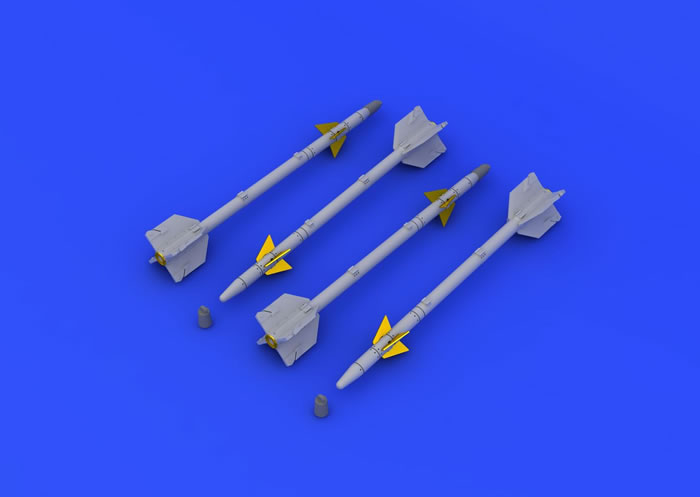AIM-9E Sidewinder

(CAD illustration courtesy of Eduard website)
Eduard BRASSIN, 1/72 scale
S u m m a r y : |
Catalogue Number |
Eduard BRASSIN Item No. 672063 - AIM-9E SidewinderEight resin parts, a PE fret of twenty-six pieces, and decals. |
Contents and media |
Eight resin parts, a PE fret of twenty-six pieces, and decals. |
Scale |
1/72 |
Price: |
Available online from these stockists:
|
Review Type |
First Look |
Advantages: |
Superb quality and spare PE parts. |
Disadvantages: |
|
Recommendation: |
Eduard Brassin’s AIM-9E Sidewinders are very nicely rendered. They offer an excellent detail refinement opportunity for many modern Western fighter subjects from the 1960’s & 70’s. I definitely recommended them. |
Reviewed by Mark Davies

Eduard's BRASSIN 1/72 AIM-9E Missiles are available online from Squadron.com
The AIM-9 Sidewinder is a short-range air-to-air missile developed by the United States Navy in the 1950s. Entering service in 1956, variants and upgrades remain in active service with many air forces after five decades. The United States Air Force purchased the Sidewinder after the missile was developed by the United States Navy at China Lake, California.
Nearly 100,000 of the first generation (AIM-9B/C/D/E) of the Sidewinder were produced with Raytheon and General Electric as major sub-contractors. Philco-Ford produced the guidance and control sections of the early missiles. The NATO version of the first generation missile was built under license in Germany by Bodenseewek Geratetechnik, 9,200 examples were built. A second generation of the missile (AIM-9G/H/J) was introduced during 1970 and these were followed from the mid-seventies by the AIM-9L/P) which was a substantial improvement on the early versions particularly with an improved SR-116 reduced-smoke rocket motor. The third generation of the missile (AIM-9L/M) is an all-aspect missile which shares little in common with the earlier missiles.
Source: Wikepedia
If “The One True Scale” has a weakness (and I’m not admitting it does!), it is that the missiles supplied with 1/72 kits often suffer from over-scale fins due to the limitations of injection moulding, as well as sometimes having simplified detail in other areas. The usual solution for the former issue is to use PE fins, whilst better overall detail can be obtained by casting in resin. (Although, I have seen 3D-printed missiles with very fine fins, and there is the laborious option of scratch building if you have the skill and patience.)
Predictably, Eduard Brassin uses resin and photo-etched brass to provide us with four examples of the AIM-9E Sidewinder. This will be most welcome to modellers of 1960’s and 70’s fighters.
The four missiles come attractively packaged in a blister pack with sponge cushioning. Very clear instructions are included, with colour call-outs cross-referenced to the Gunze Aqueous and Mr Color paint ranges. A small sheet of decals provides for the missile markings. A PDF copy of the instructions is downloadable from Eduard’s website.
The quality of casting is excellent, with the pour subs attached to the tail fins. Separate protective covers for the seeker-heads are supplied in resin, but you will have to cut the seeker-heads from the missile fuselages if you plan to use these. The forward fins are made of PE; sixteen being required to complete four missiles, although twenty are supplied, so you have four spare. Six PE rings are included to represent the rocket motor exhausts, so two are spare.
Painted and decaled, these Sidewinders should be an excellent addition to any suitable model; they are sure to be a vast improvement over any injected kit items. Eduard offers a very similar 1/48 scale set of four AIM-9E’s as Brassin 648196.
Eduard Brassin’s AIM-9E Sidewinders are very nicely rendered. They offer an excellent detail refinement opportunity for many modern Western fighter subjects from the 1960’s & 70’s. I definitely recommended them.
Thanks to Eduard for the samples and images.
Review Text Copyright © 2015 by Mark Davies
Page Created 16 August, 2015
Last updated
16 August, 2015
Back to HyperScale Main Page
Back to Reviews Page

|
